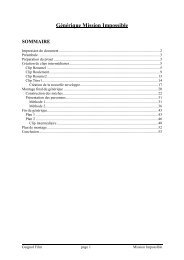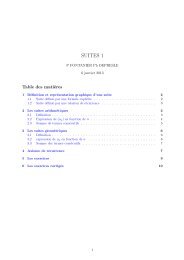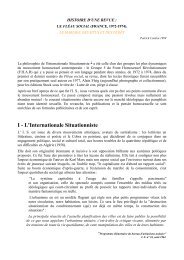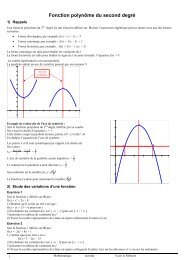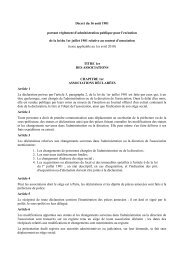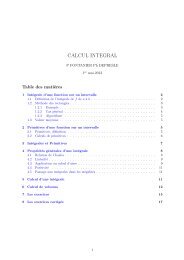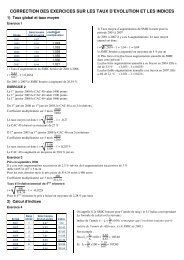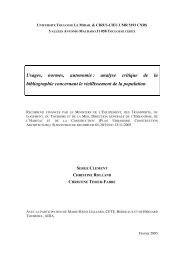internationalisation in science in the prism of bibliometric indicators
internationalisation in science in the prism of bibliometric indicators
internationalisation in science in the prism of bibliometric indicators
You also want an ePaper? Increase the reach of your titles
YUMPU automatically turns print PDFs into web optimized ePapers that Google loves.
collaboration space, as shown with o<strong>the</strong>r methods by Leydesdorff, 2000,<br />
Grande and Peschke 1999 (for an earlier picture see Moed et al., 1991).<br />
However, some changes <strong>in</strong> aff<strong>in</strong>ity pr<strong>of</strong>iles <strong>of</strong> European peripheral<br />
countries is noted (Bassecoulard et al., 2001). Of course <strong>in</strong> <strong>the</strong> long<br />
run, geopolitical if not cultural relations rearrange networks.<br />
Political decisions and geopolitical earthquakes have transformed<br />
historical aff<strong>in</strong>ity between <strong>the</strong> US and Japan, Western and Eastern-<br />
Europe countries (Braun & Glaenzel, 1996), or at a lesser extent France<br />
and Russia or South America. But <strong>the</strong> stability <strong>in</strong> <strong>the</strong> medium run is<br />
quite remarkable. Infrastructural factors are a first natural<br />
explanation to <strong>the</strong> <strong>in</strong>ertia <strong>of</strong> channels. The literature address<strong>in</strong>g <strong>the</strong><br />
various determ<strong>in</strong>ants <strong>of</strong> collaboration flows usually reta<strong>in</strong>s geographic<br />
proximity, cultural/geopolitical proximity, <strong>in</strong>clusion <strong>in</strong> <strong>the</strong> same<br />
<strong>in</strong>novation system or nation. A detour by with<strong>in</strong>-countries observation<br />
may be helpful.<br />
4. A regional detour<br />
Studies at <strong>the</strong> regional level with<strong>in</strong> a country gave evidence <strong>of</strong><br />
geographic proximity effects (Katz, 1993). Address<strong>in</strong>g <strong>in</strong>ternational<br />
exchanges with a f<strong>in</strong>er (<strong>in</strong>fra-national) breakdown allows to surmount a<br />
limitation <strong>of</strong> purely <strong>in</strong>ternational measures <strong>in</strong> assess<strong>in</strong>g <strong>the</strong> specific<br />
role <strong>of</strong> national borders. Their effect can be tested aga<strong>in</strong>st a<br />
reference, namely regional borders. Study<strong>in</strong>g <strong>the</strong> case <strong>of</strong> France and its<br />
neighbour countries, Okubo & Zitt (2004) show <strong>the</strong> overwhelm<strong>in</strong>g role <strong>of</strong><br />
national borders, even <strong>in</strong> <strong>the</strong> case <strong>of</strong> border regions such as Alsace<br />
with bicultural traditions. The relative <strong>in</strong>ertia <strong>of</strong> channels observed<br />
at <strong>the</strong> <strong>in</strong>ternational level is also witnessed to a large extent at <strong>the</strong><br />
<strong>in</strong>ter-regional level. With<strong>in</strong> more closely connected countries<br />
(Scand<strong>in</strong>avia), cross-border regions with strong <strong>in</strong>centives such as<br />
Oresund may result <strong>in</strong> trans-border systems, but it is perhaps too early<br />
to assess such developments.<br />
The regional detour corroborates <strong>the</strong> hypo<strong>the</strong>ses that proximity<br />
factors underp<strong>in</strong>n<strong>in</strong>g collaboration networks rank as follows:<br />
<strong>in</strong>stitutional/ national system (which also embody historical and<br />
cultural impr<strong>in</strong>ts); history, geopolitics, language and culture;<br />
geographic proximity. O<strong>the</strong>r factors, less stable <strong>in</strong> <strong>the</strong> long range such<br />
as <strong>the</strong>matic proximity, are also likely to play an important role.<br />
Various factors have been comb<strong>in</strong>ed <strong>in</strong> regression/ gravity models<br />
(Nagpaul, 1999, see also <strong>the</strong> chapter by Guellec & Van Pottelsberghe on<br />
technology).<br />
A second explanation to stability should probably be sought at <strong>the</strong><br />
<strong>in</strong>dividual level. The "quasi-neuronal" persistence <strong>of</strong> <strong>in</strong>ter-<strong>in</strong>dividual<br />
or <strong>in</strong>ter-<strong>in</strong>stitutional l<strong>in</strong>kages is a form <strong>of</strong> uncerta<strong>in</strong>ty reduction<br />
behaviour, with last<strong>in</strong>g l<strong>in</strong>kages based on trust and ma<strong>in</strong>ta<strong>in</strong>ed through<br />
face-to-face <strong>in</strong>teractions <strong>in</strong> meet<strong>in</strong>gs, conferences, etc. Comb<strong>in</strong>ed with<br />
<strong>the</strong> <strong>in</strong>fra-structural background, this factor could account for much <strong>of</strong><br />
<strong>the</strong> relative <strong>in</strong>ertia observed at <strong>the</strong> aggregate level, <strong>in</strong>clud<strong>in</strong>g at <strong>the</strong><br />
<strong>in</strong>ternational level.




